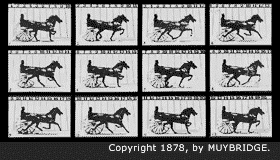Time-lapse photography
is a method of recording events over long periods of time that can later
be played back in much shorter periods of time. Instead of shooting
film frame-by-frame as a continuous movie, time-lapse works by shooting
a single frame of film, then waiting for an interval of time before
shooting the next frame. The longer the intervals between shots, the
faster time will appear to pass when the final film is played. For example
- to go 1 meter by snail would take 20 minutes. A time-lapse film could
show this snail-walking in 15 seconds.
The origins
of time-lapse photography probably date back to the 1870s, when San
Francisco photographer Eadweard Muybridge began a series of motion studies
at the request of Leland Stanford.
Stanford, who owned a stable of thoroughbred race horses, was determined
to understand every scientific fact he could about his prized animals,
including whether all four feet ever left the ground simultaneously.
Muybridge used a series of 12 stereoscopic cameras installed in a 50-foot
shed abutting Stanford's race track, and recorded the horses' movements
as they galloped past. Each frame was shot at 1/1000 of a second. The
end result was a series of cards - which could be animated by flipping
through them - and which showed that all four feet did indeed leave
the ground at once.
The series was published in 1878 as "The Horse in Motion."





